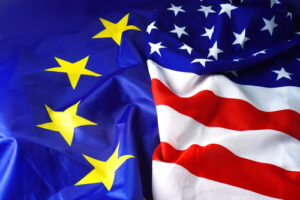The Evolving Trade Landscape: A Closer Look at EU-U.S. Relations
In recent weeks, the European Union’s trade relations with the United States have come under the spotlight, primarily due to the escalating tensions surrounding tariffs on steel and aluminum. At the heart of this discussion is European Commission President Ursula von der Leyen’s ambitious proposal for a zero-for-zero tariff deal. However, this initiative comes at a time when the EU faces significant internal divisions—and the stakes couldn’t be higher.
A Complicated Proposal: The Zero-for-Zero Tariff
President von der Leyen has extended an olive branch to the U.S., advocating for a zero-for-zero tariff deal on industrial goods. "We stand ready to negotiate," she stated, highlighting Europe’s openness to fostering goodwill and strengthening trade relationships with the U.S. But there’s a catch: this proposal arrives on the heels of a hefty 25% tariff imposed by the U.S. on European steel and aluminum, followed swiftly by an additional 20% levy.
While some EU nations, like the Netherlands under Trade Minister Reinette Klever, are keen on de-escalation and cooperation, France’s stance diverges sharply. French leaders, including Minister Laurent Saint-Martin and President Emmanuel Macron, are urging a more aggressive approach, contemplating retaliatory measures that could deepen transatlantic tensions. This internal discord raises important questions about the EU’s unified front in international negotiations.
The Trump Factor: An Impasse or Opportunity?
It’s difficult to overlook the influence of former U.S. President Donald Trump on this ongoing dialogue. Trump has voiced skepticism regarding the zero-for-zero approach, declaring it insufficient given the U.S. trade deficit with the EU, which he estimates to be around $350 billion. His strategy hints at leveraging energy exports as a bargaining chip, suggesting that the EU could significantly reduce its deficit by committing to purchase American liquefied natural gas.
While von der Leyen acknowledged this potential avenue for collaboration, the EU’s reliance on energy imports remains a pressing concern. With the ongoing conflict in Ukraine and the subsequent cut-off of Russian oil, Europe’s quest for stable energy sources is more crucial than ever. The need for a strategic partnership with the U.S. on energy supply could reshape the narrative in this complex relationship.
The Bigger Picture: The EU’s Struggles with Centralization
The current trade tensions symbolize a broader issue facing the European Union: the challenges of maintaining a centralized governance structure in a diverse region with varying national interests. The extent to which Brussels has historically prioritized a uniform agenda over localized needs is becoming increasingly evident.
Countries in Eastern Europe, which have been heavily reliant on Russian energy, find themselves caught in a geopolitical crossfire, with the EU’s decisions often feeling disconnected from the realities of their individual economies. This discontent suggests that many nations within the EU are beginning to recognize their loss of autonomy and the adverse effects of centralized decision-making.
As we reflect on these dynamics, it’s clear that the notion of a seamless, cooperative EU may be more aspirational than achievable. The voices and specific needs of individual nations are becoming harder to ignore, particularly as economic conditions shift and political pressures mount.
Conclusion: Charting the Course Ahead
The evolving EU-U.S. trade relationship represents a pivotal moment in international economics, one defined by uncertainty and opportunity. As tensions rise and negotiations unfold, the challenges of disparate national interests and centralized governance will continue to permeate discussions at all levels.
At Extreme Investor Network, we are dedicated to providing in-depth analysis and expert insights on these developments and their implications for global economics. As the landscape shifts, stay tuned for more updates and analysis that can help you navigate the complexities of international trade and investment. Together, we can understand these multifaceted issues and their potential impacts on your portfolio and our economies at large.
By engaging with our content, you not only stay informed but also gain valuable perspectives that can enhance your investment strategies in an increasingly interconnected world.

